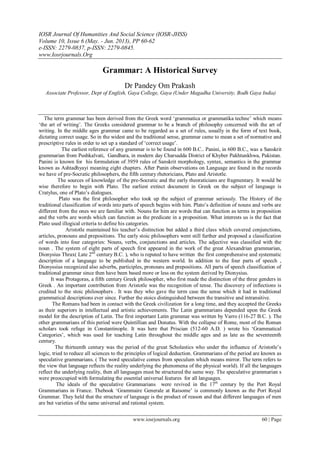The document presents a historical survey of grammar, tracing its origins from Greek philosophy to modern linguistic theories. It highlights significant contributions from figures like Panini, Plato, and Aristotle, outlining the evolution from traditional grammar to transformational generative grammar introduced by Noam Chomsky. The narrative examines various grammatical classifications and methods, emphasizing the distinction between linguistic competence and performance.


![Grammar: A Historical Survey
www.iosrjournals.org 62 | Page
The two main devices of grammatical analysis are: (a) Breaking up a string (b) labeling the
constituents. There are three kinds of breaking up: (i) Sequential (ii) Hierarchical (iii) Transformational
Similarly there are three kinds of labeling: (i) Morphhological (ii) Categorical (iii) Functional. A grammar is
free to choose and combine any of the techniques of cutting and labeling. Depending upon what tools the
grammar chooses, we have different types of grammar. If a generative grammar makes use of sequential cutting
up only, it is called Finite State grammar. If a generative grammar makes use of hierarchical cutting up and no
transformation, it is called Phrase Structure Grammar. A generative grammar that makes use of all the three
(sequential, hierarchical and transformational) it is called Transformational Generative grammar.
References:-
[1]. Hocket, C.F. (1958) A Course in Modern Linguistics, New York: Macmillan
[2]. Huddleston, R. (1984) Introduction to the Grammar of English, Cambridge: Cambridge University Press
[3]. Palmer, F.R. (1981) Grammar, Harmondsworth: Penguin .](https://image.slidesharecdn.com/i01066062-130524012424-phpapp01/85/I01066062-3-320.jpg)